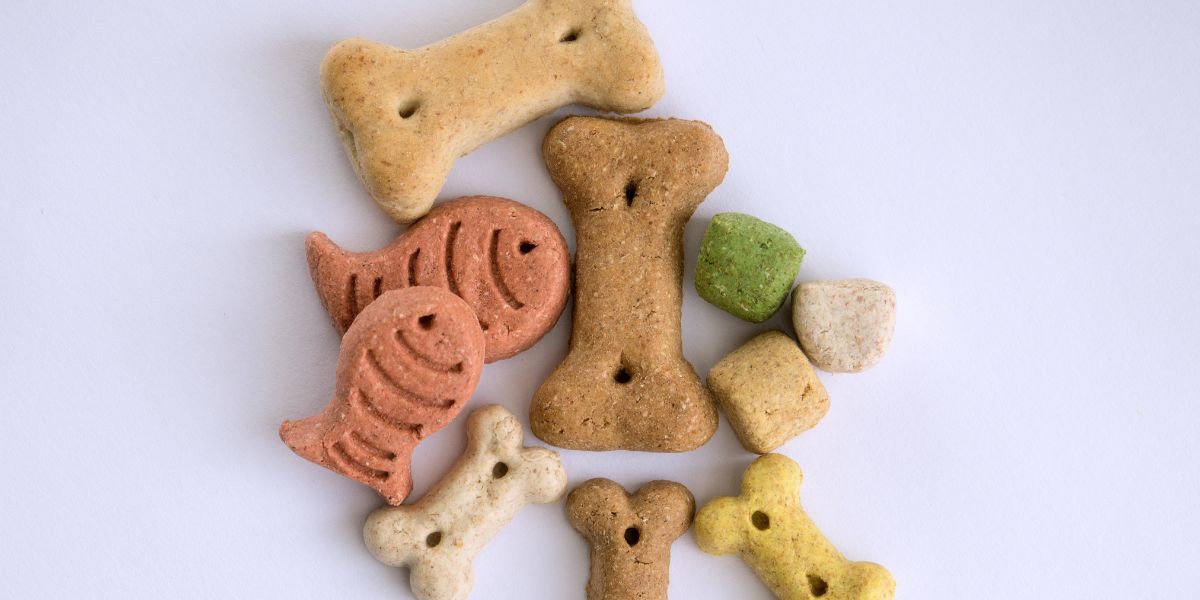Dogs are no less than a family member. They require love, care, and proper training to grow into well-behaved companions.
Training is integral to every dog’s life, but what makes the process more effective? You guessed right – it’s treats!
These “tasty incentives” have a unique way of speaking straight to their hearts! Treats can transform your training sessions from exhausting power struggles to enjoyable learning experiences, whether dealing with an exuberant puppy or a headstrong adult dog.
The magic lies in the rewards-based training method.
Think about it this way – wouldn’t you feel motivated if your hard work was recognized and appreciated rightfully?
The same logic applies to our four-legged friends as well.
Rewarding dogs with tasty tidbits whenever they demonstrate positive behavior encourages them to elicit such actions more often and engage better during these vital teaching moments.
But here comes the twist – how do we decide among countless treat options available out there?
If these questions cloud your mind, too, you’re exactly where you need to be!
Sit tight as we unfold all the secrets behind choosing the best treats for doggie training that take their effectiveness up by several folds—making both your canine buddy’s teeth slurp in delight and tail waggle like never before!
Decoding the Science Behind Effective Training Treats
Choosing the perfect training treat is a high-wire act of balancing your canine’s taste preferences, nutritional needs, and training objectives.
Some treats can be classified as ‘high-value’ – these are often mouth-watering and irresistible to our pups, such as cuts of chicken or cheese.
These types can create significant motivation during challenging training scenarios.
Conversely, low-value treats such as store-bought kibble may suffice for home-based obedience drills with fewer distractions.
A treat’s size, texture, and aroma are critical considerations when tailoring choices to support effective doggy discipline.
Smaller morsels offer portion control and allow frequent rewards without overfeeding during repeated exercises.
Soft treats may appeal to puppies with sensitive teeth. In contrast, crunchy ones help maintain adult dogs’ dental health, And aromatic snacks further ignite your pet’s primal instincts, amplifying their power as positive reinforcement tools in upper schooling.
Analyzing from treat-type perspectives reveals two significant categories: commercially available products and homemade alternatives.
The former offers convenience at potentially higher costs plus risks of artificial additives – on the other hand, they usually carry essential nutrition information, helping owners monitor caloric intake more conveniently.
Homemade variants give you full sovereignty over ingredients, ensuring wholesomeness, but require investment in time and effort into preparation, plus expert insight into creating nutritionally balanced canine confectioneries.
Top Commercially-Available Puppy Treats
A) Chewy Soft Treats – Recommended brands and flavors: When training puppies, many owners prefer chewy soft treats due to their palatability and easy-to-chew texture.
Zuke’s Mini Naturals is a highly recommended brand with various flavors like roasted chicken, peanut butter, and salmon.
These treats are not only small and easily digestible for little mouths but also contain wholesome ingredients such as real meat or fish as the primary source of protein.
Another popular choice is Wellness WellBites Soft Natural Dog Treats, known for their soft consistency that makes them ideal for training sessions.
With flavors like turkey & duck or lamb & salmon, these treats are both flavorful and healthy – free from artificial additives or fillers commonly found in other commercial brands.
B) Small Bite-Sized Crunchy Treats – Popular choices among trainers:
Several options are also available for some puppy owners who prefer crunchy treats that provide a satisfying crunch while being low in calorie count.
One top pick among trainers is Blue Buffalo Blue Bits Training Dog Treats.
Made with natural beef as the first ingredient and packed with antioxidant-rich blueberries, these tiny bite-sized morsels offer flavor and nutritional value without compromising quality.
Additionally, Nutro Crunchy Real Apple Dog Biscuits deserve a mention when discussing favorite crunchy puppy training treats.
Made with whole grains and infused with natural apple puree flavoring, these biscuits are irresistible even for pickier eaters while providing essential fiber necessary for optimal digestion.
Selecting the correct type of treat can significantly impact your puppy’s motivation during training sessions.
With an array of commercially available options catering specifically to puppies’ needs – whether they lean towards chewy softness or crave that rewarding crunch – finding the perfect treat becomes more attainable.
Recommendation for Homemade Puppy Dog Treat Recipes
A) Healthy & Easy-to-make recipes using everyday ingredients:
When training your puppy, homemade treats can be a great option.
Not only do they allow you complete control over the ingredients, but they also allow you to create tasty and healthy rewards that your furry friend will love.
One of the best things about making your treats is that you can use everyday kitchen staples that are already in your pantry.
A straightforward recipe that is always a hit with puppies is peanut butter banana bites.
You only need ripe bananas, natural peanut butter, and whole wheat flour. Mash up the bananas until they form a smooth consistency, then mix in the peanut butter and flour until it forms a dough-like texture.
Roll out small bite-sized balls and bake them in the oven at 350 degrees Fahrenheit for 10-15 minutes or until golden brown.
These delicious treats are packed with nutrients from bananas and provide protein-rich peanut butter as an excellent energy source for active puppies.
B) Tips for successful DIY treat making:
Making homemade dog treats can be fun and rewarding, but there are vital tips to remember for successful results.
First, always follow any dietary restrictions or allergies your puppy may have when selecting ingredients.
Secondly, pay attention to portion sizes – while it’s tempting to give your pup more significant portions because they’re homemade, remember that moderation is vital.
Additionally, don’t hesitate to get creative with different flavors!
Just like humans enjoy variety in their snacks, dogs appreciate diversity too.
Consider adding grated carrots or shredded cheese into treat recipes; this adds nutritional value and gives each batch its unique taste profile.
Lastly and most importantly, ensure all ingredients used are safe for dog consumption!
Some human foods may contain harmful substances, such as onions or chocolate, which can be toxic if ingested.
Always do your research and consult a veterinarian if you are unsure about the safety of any ingredient.
Following these healthy homemade treat recipes and tips will provide your puppy with nourishing rewards during training, and have fun experimenting in the kitchen while strengthening the bond between you and your furry friend.
Benefits of Using Freeze-Dried or Dehydrated Meat As Dog Training Rewards
A) Nutritional advantages: One of the key benefits of using freeze-dried or dehydrated meat as dog training rewards is their nutritional value.
Unlike traditional dog treats that are often packed with preservatives and artificial ingredients, freeze-dried or dehydrated meats retain much of their natural nutrients.
They offer a high protein content, essential for muscle development and overall dog health.
These treats often contain minimal additives and fillers, making them healthier.
B) Long shelf-life options: Another advantage of using freeze-dried or dehydrated meat as dog training rewards is their extended shelf life.
These treats undergo a unique preservation process that removes moisture while keeping the flavors intact.
This results in products that can stay fresh for months without refrigeration — perfect for taking on outdoor adventures or storing in your pantry for occasional use.
With longer expiration dates, you won’t have to worry about wastage due to spoilage.
C) Brands are known for high-quality offerings:
When selecting freeze-dried or dehydrated meat as training rewards for your furry friend, several reputable brands are worth considering.
For example, Brand X specializes in sourcing ethically-raised meats from local farmers and uses sophisticated dehydration techniques to lock in flavor naturally.
On the other hand, Brand Y offers a range of grain-free options made from premium cuts of meat sourced solely from trusted suppliers.
By choosing brands known for their commitment to quality ingredients and reliable production processes, you can ensure you provide your dog with only the best treats during training sessions.
Using Fruit and Vegetable Treats in Training
A) Example fruits and veggies that make good training treats
When incorporating natural options into your dog’s training routine, fruits and vegetables can be an excellent choice.
Not only do they offer a refreshing change of flavor from traditional meat-based treats, but they also provide added health benefits.
Some examples of fruits that make great training treats are blueberries, strawberries, and apple or banana slices.
These bite-sized goodies are tasty and packed with essential vitamins and antioxidants that promote the overall well-being of your furry friend.
In addition to fruit options, an array of vegetables can serve as excellent training rewards.
Carrot sticks or baby carrots are crunchy snacks that dogs often find satisfying while being low in calories.
Green beans are another option worth considering – their crisp texture makes them perfect for chewing during obedience sessions.
Experimenting with different combinations of fruits and veggies will allow you to discover which ones best capture your dog’s attention during training.
B) Benefits of using natural options
Opting for natural treatment choices like fruits and vegetables has several advantages over processed alternatives.
Firstly, these wholesome snacks have fewer additives or preservatives than commercial treats, making them healthier overall for your pup.
They contain higher nutrients, such as vitamins A and C, crucial for optimal health.
Moreover, using fruit and vegetable treats provides an opportunity to diversify your dog’s diet without compromising their nutritional needs.
Introducing this variety into their routine enriches their mealtime experience while ensuring they receive vital micronutrients necessary for growth and vitality.
Additionally, many dogs thoroughly enjoy the taste sensation offered by these natural options.
The sweetness from berries or the refreshing crunchiness provided by carrots adds excitement to their training regimen while aligning with a balanced lifestyle.
Incorporating fruit and vegetable treats into your dog’s training enhances their focus and engagement and promotes a healthier and more well-rounded diet.
By diversifying their rewards with natural options, you can ensure that your furry companion receives both mental stimulation and the nutrients they need to thrive.
Special Considerations for Dogs with Allergies or Dietary Restrictions
A) Hypoallergenic treatment alternatives:
For dogs with allergies, finding suitable treats can be a challenge. Many traditional dog treats contain common allergens like beef, chicken, wheat, and soy.
However, many hypoallergenic treatment alternatives can cater to these dogs’ needs.
Firstly, consider treats from novel protein sources such as venison or duck.
These proteins are less commonly used in dog food and have a lower chance of triggering allergic reactions.
Additionally, look for treats free from joint fillers like corn or artificial additives that may irritate sensitive digestive systems.
Another option is to explore homemade treat recipes using alternative ingredients like sweet potatoes or lentils.
These natural ingredients are often well-received by allergic dogs and can easily be customized to suit their dietary restrictions.
B) Grain-free and limited ingredient options:
Grain-free treats have gained popularity among dogs with allergies and pet owners who prefer to feed their furry friends a more ancestral diet.
By eliminating grains such as wheat and corn from the recipe, grain-free treats provide an alternative source of carbohydrates to support your dog’s energy levels without causing any gastrointestinal distress.
Limited-ingredient treats are another excellent choice for dogs with dietary restrictions.
These treats usually contain only one protein source and minimal additional ingredients – perfect for pups with sensitivities.
Look out for labels on the packaging indicating limited ingredients when choosing your training rewards.
Lastly, consult your veterinarian before changing your pup’s diet or introducing new treats if they have significant allergies or dietary concerns.
They can recommend specific brands or ingredients based on your dog’s needs and help you navigate the right choices for optimum health and balance in training sessions.
The Art of Using Sparsely but Smartly: Dos and Don’ts of Treat-Based Training
When it comes to practical treat-based training, timing is everything. Your pet’s reward should be given immediately after the desired behavior occurs, ideally within half a second.
Doing so makes a clear connection in your dog’s mind between their action and the yummy reward.
This concept is known as ‘marking’ – capturing that perfect moment when your canine pal does precisely what you’ve asked.
While treats can be compelling motivators for dogs, try not to over-rely on them during training sessions.
The ultimate goal is for your dog to respond to cues because they want to please you—not solely motivated by a snack waiting in hand.
Moreover, excessive reliance on treats can lead to obesity or nutritional imbalance if used too frequently.
So remember—this tactful tool needs moderation!
Additionally, adjust the size of each treat according to the size of your dog and the frequency of rewarding behavior.
Small bite-sized pieces work best since they won’t fill up your furry friend too quickly while providing instant gratification, which keeps the momentum going during training sessions.
The Impact of Proper Treat Selection in Dog Training
Choosing the proper training treats is about more than rewarding your four-legged friend when they obey a command or exhibits good behavior.
It’s about nurturing a beneficial bond and encouraging behavioral momentum that will be invaluable throughout their lives.
The most effective dog owners understand this distinction, utilizing treats as stepping stones towards healthier habits rather than only reserving them for sporadic celebrations.
Treats are powerful facilitators in enhancing learning and shaping behavior patterns among dogs.
When used appropriately, they accelerate learning by creating a positive association with desired actions, cultivating robust behavioral chains over time.
They immediately indicate to your furry companion that they’ve done something correctly – simplicity that resonates immensely with canines regardless of breed or age.
Furthermore, integrating variety in treat selection stimulates interest during training sessions and promotes overall dietary balance; it shouldn’t always be about fatty snacks or commercial doggy biscuits!
Different textures like crunchy fruits or chewy meats alongside kibble offer varied sensory experiences for your pet while ensuring nutrient adequacy across other food classes — all working symbiotically to foster more engaging teaching moments between you and your pup.





